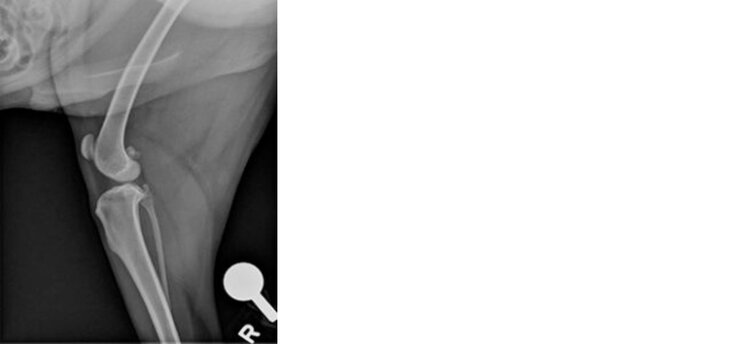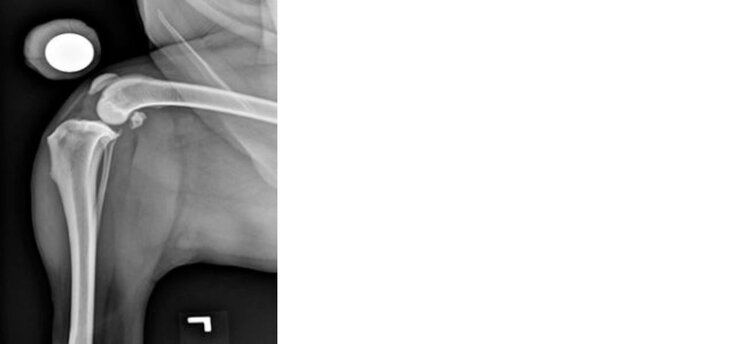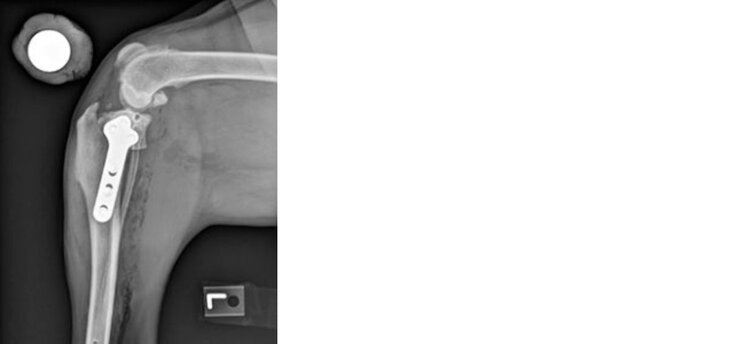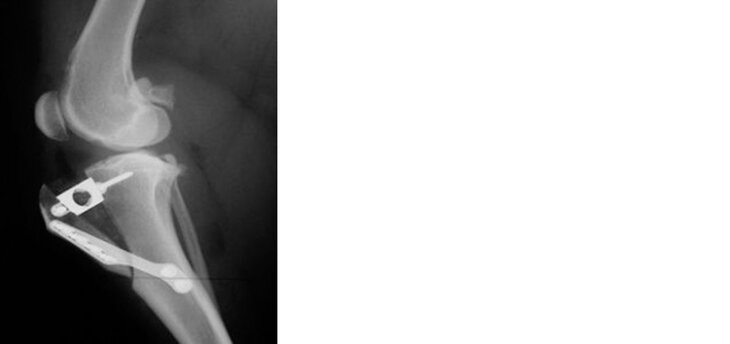How Much Does Cranial Cruciate Ligament Surgery for Dogs Cost?
It’s the moment every dog parent dreads: your pup limps back from a game of fetch, favoring one leg, eyes wide with confusion. After a trip to the vet, you learn the diagnosis is a cranial cruciate ligament (CCL) tear. Unfortunately, this injury is common in dogs and can come with a hefty price tag.
CCL surgery is one of the most frequently performed orthopedic procedures in veterinary medicine. But depending on where you live, the size of your dog, and which surgical method you choose, the cost can range from a few thousand to more than five grand.
Planning ahead with pet insurance can help soften the financial blow, but if you're wondering what to expect, you’re not alone.
Key takeaways
- Cruciate ligament injuries are among the most common orthopedic issues in dogs.
- Symptoms include limping, difficulty standing, and decreased activity.
- Treatment can range from conservative management to surgery, costing $1,000–$5,000+.
- Surgery options include extracapsular repair, tibial plateau leveling osteotomy (TPLO), and tibial tuberosity advancement (TTA), each with different pros, cons, and price points.
- Costs vary based on location, breed, weight, and post-op care.
- Pet insurance can significantly reduce out-of-pocket costs when purchased before the injury occurs.
Looking to save on vet bills? See if pet insurance is right for you.
Instant results. No spam. 1M+ pet parents served.
In this guide, we’ll break down everything you need to know, from what a cruciate ligament injury is to how much surgery and recovery cost, and how to make the procedure more affordable.
✔️ Reviewed by multiple licensed veterinarians
✔️ Updated with the latest medical data
✔️ Compiled from veterinary research
- What is a cranial cruciate ligament injury in dogs?
- Diagnosis and treatment options for cranial cruciate ligament tears
- How much does cranial cruciate ligament surgery cost for dogs?
- Factors that influence cranial cruciate ligament surgery costs
- Post-operative recovery & rehabilitation costs
- How to save money on cranial cruciate ligament surgery
- Does pet insurance cover cranial cruciate ligament surgery?
- FAQs
What is a cranial cruciate ligament injury in dogs?
The CCL in dogs is similar to the anterior cruciate ligament (ACL) in humans. It connects the thigh bone (i.e., femur) to the shin bone (i.e., tibia) and stabilizes the knee joint. The knee becomes unstable when the CCL tears, causing pain and weakness.
Common causes of a CCL tear include genetics, obesity, aging, and high-impact activities like jumping and sudden turns. Larger breeds, including the Labrador Retriever and German Shepherd, are especially prone to this injury.¹
“Look out for symptoms like limping, reluctance to play, difficulty standing, or even a noticeable ‘pop’ at the moment of injury,” says Dr. Angela Beal DVM, FFCP. “If left untreated, a cruciate ligament tear can progress to arthritis or cause more serious joint damage.”

Source: Colorado State University College of Veterinary Medicine and Biomedical Sciences

Source: Colorado State University College of Veterinary Medicine and Biomedical Sciences
Diagnosis and treatment options for cranial cruciate ligament tears
Diagnosing a CCL injury
“We usually start with a physical exam to check for swelling or joint instability, such as the classic ‘drawer sign,’” explains Dr. Angela Beal DVM, FFCP. “If we suspect a cruciate tear, we’ll move on to imaging. X-rays help rule out other issues, while MRI or arthroscopy can confirm the diagnosis.”²
Diagnostic costs can run between $200 and $500, depending on where your dog receives care and whether advanced imaging is needed.
Treatment approaches
For small dogs or minor tears, conservative treatment with rest, anti-inflammatory medications, and rehabilitation may allow for sufficient healing. This approach typically costs less than surgery at $500–$1,500, but the success rate is low in large or active dogs.
Surgery is often the best option for long-term recovery. There are three main types:
1. Extracapsular repair (lateral suture)5
- Cost: $1,000–$2,500
- Best for smaller dogs, this technique uses suture to stabilize the knee. It's less invasive but may not hold up well in larger breeds.
2. Tibial plateau leveling osteotomy (TPLO)
- Cost: $3,500–$5,000
- TPLO alters the knee's structure to eliminate instability. This surgery is suitable for large, active dogs because of its durability.
3. Tibial tuberosity advancement (TTA)
- Cost: $3,000–$4,500
- TTA is similar to TPLO but involves repositioning a different part of the tibia. Recovery and effectiveness are comparable.
Each approach has pros and cons, so your vet will consider your dog’s size, age, breed, lifestyle, and overall health to determine which one offers the best prospects for a good long-term outcome and quality of life.³

Source: Colorado State University College of Veterinary Medicine and Biomedical Sciences

Source: Colorado State University College of Veterinary Medicine and Biomedical Sciences
How much does cranial cruciate ligament surgery cost for dogs?
Cost breakdown by surgery type
CCL surgery for dogs costs anywhere from $1,500 to $6,000, depending on the procedure type, geographic location, and your dog’s individual needs.
In addition to the base cost of surgery, several essential add-ons can significantly increase your total bill, including:
- Anesthesia: $200–$500
- Hospitalization: $300–$1,000
- Post-op medications: $50–$200
- Follow-up visits: $100–$300
Cost variations by location
Where you live influences the cost more than you think. Like rent or groceries, veterinary service pricing can vary significantly depending on your region. In major metropolitan areas, such as New York City, San Francisco, or Los Angeles, you’re not only paying for the surgery itself, but also for the overhead costs of operating in high-rent districts and the availability (or scarcity) of board-certified surgeons.
Prices may be 25% to 50% higher in big cities than in smaller towns or rural communities.
Compare costs for CCL surgery in rural versus urban areas:
- Rural Midwest: $2,500–$3,500
- Major cities: $4,000–$6,000
Bilateral surgery costs
About half (40% to 60%) of dogs who tear one CCL will tear the other within two years. If both knees are affected, your dog may need two separate procedures, increasing costs and overall recovery time.⁴
Factors that influence cranial cruciate ligament surgery costs
- Size and weight: Larger dogs need stronger implants and may require longer surgery time.
- Severity of the injury: Complete tears often require more complex repairs than partial tears.
- Surgeon experience: Board-certified veterinary surgeons may charge more than a family vet, but using a specialist reduces the risk of complications.
- Post-op care: Rehab, meds, and follow-up appointments can add hundreds to the final bill.
- Insurance: Pet insurance can drastically offset costs when the policy is in place before the injury.
Post-operative recovery & rehabilitation costs
Recovery timelines vary depending on the surgery your dog undergoes and their age, weight, and overall health. Some dogs bounce back faster than others, especially with the help of structured rehabilitation.
Here's what you can typically expect for recovery time from each surgical method:
- Extracapsular repair: 8 to 12 weeks
- TPLO or TTA: 6 to 10 weeks, including rehabilitation
Post-op rehabilitation costs
Your dog may appear healed before the full recovery window has passed, but it's crucial to follow your vet’s post-op instructions closely to avoid setbacks. Costs for recommended rehabilitation may include:
- Physical therapy: $50 to $100 per session
- Hydrotherapy: $40 to $80 per session
- Supplements: $20 to $50 per month
- Check-ups and medications: $200 to $500 total
Investing in recovery helps prevent re-injury and improves long-term mobility.
How to save money on cranial cruciate ligament surgery
Pet insurance
One of the most effective ways to reduce the financial burden of cruciate ligament surgery is to enroll in a comprehensive pet insurance plan—ideally before your dog ever needs it.
Pet insurance works a lot like human health insurance. You pay a monthly premium in exchange for coverage of eligible medical expenses, such as diagnostics, surgeries, medications, and rehab. Accident and illness plans often cover the diagnosis and surgical treatment of a CCL injury, provided the condition wasn’t pre-existing at the time of enrollment. Early enrollment is key— don’t wait until your pup is limping to start thinking about coverage.
Depending on your plan, pet insurance may reimburse you for 70% to 90% of covered costs after meeting your annual deductible. Having a plan could mean the difference between paying $5,000 out-of-pocket or only a few hundred dollars in co-pays.
Note that some insurers enforce bilateral exclusions, which means that if one knee is injured before enrollment, the other may not be covered down the line. Additionally, some plans have long waiting periods for cruciate injuries, which means your pet may not be eligible for coverage if an injury happens in the first few months of the policy. Read the fine print carefully.
Payment plans & veterinary financing
Programs like CareCredit and Scratchpay offer low-interest or interest-free payment options. Many clinics also offer internal payment plans if you ask.
Non-profit assistance programs
Organizations like RedRover Relief and The Pet Fund provide financial aid for families in need. You must apply to these programs in advance, but they can be lifesavers if you’re approved for a grant or other assistance.
Does pet insurance cover cranial cruciate ligament surgery?
As long as the injury is not considered pre-existing and does not occur during a waiting period, most accident and illness plans will cover CCL surgery. That includes costs for diagnostics, anesthesia, surgery, and sometimes post-op rehab, depending on your provider and plan.
Here are two hypothetical scenarios to show how pet insurance could help:
- A 20-pound terrier undergoes lateral suture surgery costing $3,000. With an 80% reimbursement rate and a $250 deductible, the pet parent saves around $2,200.
- A large Labrador in New York City needs TPLO surgery, totaling $5,500. With 90% coverage after a $500 deductible, the owner might pay as little as $1,050 out-of-pocket — a significant relief.
Your pet's health is priceless — let's protect it together.
FAQs
Can dogs walk with a torn cranial cruciate ligament
Some dogs can walk with a CCL injury, but the affected leg is painful and unstable. Most dogs require surgery for a full recovery.
What happens if I don’t treat a torn cranial cruciate ligament?
Untreated CCL injuries are unstable, leading to chronic pain, arthritis, scar tissue, and permanent joint damage. Delaying treatment can worsen the outcome.
Is TPLO worth the cost?
For large or active dogs, TPLO surgery is worth the cost. This surgical method offers the best chance at full mobility with fewer long-term issues.
Do you want to find the best pet insurance?
Let's analyze your pet's breed, age, and location to find the right coverage and the best savings. Ready?
Analyze My PetAbout Pawlicy Advisor
The pet insurance marketplace endorsed by veterinarians, at Pawlicy Advisor we make buying the best pet insurance easier. By comparing personalized coverage and pricing differences we can save you a ton of money, up to 83% in some instances!
Instantly Compare Pet Insurance Plans
Guides
Determine If Pet Insurance Is Worth It
Comparison Charts
Find Your State
Dog Insurance
DVM, FFCP
Dr. Angela Beal has worked in private practice and taught veterinary technicians for 15 years. Angela is a veterinarian who loves using her writing to help pet owners provide the best possible care for their furry companions. Since 2020, she has worked full-time within the veterinary education writing and editing industry. Angela lives in Columbus, Ohio with her husband, two sons, and their spoiled Chihuahua mix, Yogi.
